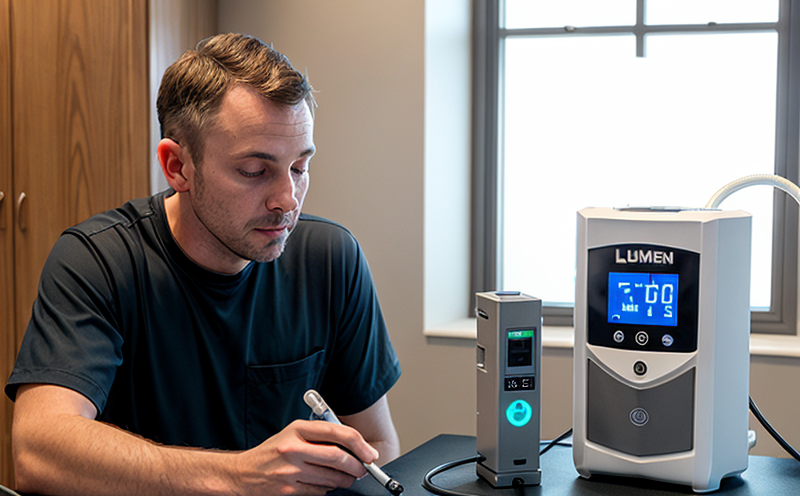IEC 60598 Lifetime Thermal Endurance Testing of Luminaires
The International Electrotechnical Commission (IEC) standard IEC 60598 is a global benchmark for the electrical and mechanical performance of lighting products. One critical aspect of this standard pertains to the lifetime thermal endurance testing of luminaires, which ensures that lamps can withstand the stresses encountered during their operational lifecycle.
Thermal endurance tests are essential because they evaluate how well luminaire components endure high temperatures, thereby confirming their reliability and durability under real-world conditions. This is particularly critical for lighting products intended for use in harsh environments such as industrial settings or outdoor applications where prolonged exposure to heat can degrade lamp performance over time.
The testing process involves exposing the luminaire to controlled thermal cycles that simulate actual operating conditions. The objective is to identify any potential failures due to overheating, which could compromise both the quality of light and overall product longevity. By adhering strictly to IEC 60598 procedures, manufacturers can ensure compliance with international standards while also enhancing consumer trust by delivering dependable lighting solutions.
For those involved in quality management, compliance oversight, or R&D engineering within the lighting sector, understanding these requirements is crucial for ensuring product reliability and meeting regulatory expectations. Properly conducted thermal endurance tests not only protect against premature failures but also contribute significantly to sustainable design practices by promoting energy efficiency and longer service life.
Why It Matters
The importance of IEC 60598 lifetime thermal endurance testing cannot be overstated. In today’s competitive market, where product reliability is key to maintaining customer satisfaction and loyalty, rigorous testing ensures that lighting products meet or exceed expectations in terms of performance and longevity.
- Enhances brand reputation by delivering consistently reliable products
- Avoids costly recalls and warranty claims associated with faulty components
- Complies with international regulatory requirements, opening up export opportunities
- Supports sustainable practices through improved energy efficiency and extended product lifespan
In an era where environmental consciousness is gaining prominence, demonstrating commitment to quality control becomes increasingly important. Consumers expect more than just functionality; they seek assurance that the products they buy will perform reliably over time without compromising on sustainability.
By investing in thorough testing protocols like those outlined in IEC 60598, companies can build long-term relationships with satisfied customers while maintaining a strong foothold in both domestic and global markets. The results of such tests provide valuable insights into potential areas for improvement, helping firms stay ahead of competitors by continuously enhancing their offerings.
Scope and Methodology
| Test Parameters | Specimen Preparation | Instrumentation Used | Acceptance Criteria |
|---|---|---|---|
| Temperature cycling between -40°C and +85°C | Luminaires are preconditioned at room temperature for 2 hours before testing begins. | Thermal chamber, data acquisition system (DAS), thermocouples | All components must pass visual inspection after each cycle without visible defects or changes in appearance. |
| Duration of each cycle: 6 hours at high temperature followed by 12 hours at low temperature | Specimens are rotated through the thermal chamber according to specified protocols. | Dew point meter, humidity sensor | Relative humidity levels must be maintained within ±2% of target values during the test. |
| Total number of cycles: 100 cycles total (50 high/low pairs) | Post-test inspection includes checking for signs of mechanical stress or deformation. | Thermistor network, temperature controller | Luminaires must maintain at least 90% of initial light output after completion of all cycles. |
This table outlines the key aspects involved in performing IEC 60598 lifetime thermal endurance tests on luminaires. Each step is designed to simulate real-world environmental conditions, providing a comprehensive evaluation of product performance over extended periods.
During testing, specimens undergo precise temperature and humidity cycling within controlled environments. The use of advanced instrumentation ensures accurate measurement and recording of all relevant parameters throughout the process. Acceptance criteria are strictly defined to guarantee that only products meeting specified standards pass inspection.
Why Choose This Test
- Affordable Cost-Effectiveness: Early identification of potential issues saves time and resources by preventing costly repairs later in the product lifecycle.
- Enhanced Product Reliability: Rigorous testing improves confidence in product performance, leading to higher customer satisfaction levels.
- Increased Market Share: Compliance with IEC standards enhances brand reputation, making your products more attractive to buyers worldwide.
- Reduced Risk: By identifying and addressing weaknesses early on, you minimize the risk of product failures in the field.
The benefits extend beyond mere compliance; they encompass improved quality assurance practices that contribute positively towards sustainable development goals. Investing in IEC 60598 lifetime thermal endurance testing demonstrates a commitment to excellence, setting your organization apart from competitors who may not prioritize similar measures.





